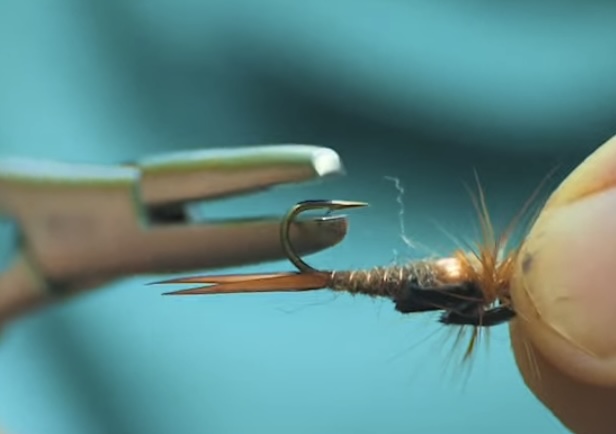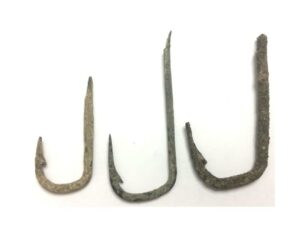When you’re choosing fishing hooks, there are several elements you need to think about. You have to consider hook size and shape. You need to think about what type of lure you’ll be using. And you need to consider whether or not you want to use a barbed hook.
For most fly fishers, the answer is always going to be barbless. But that’s not always the case! And in other types of fishing, barbed hooks may be preferable… or in some cases, even necessary. Today, we’re going to take a deep dive into the barbed vs barbless hook debate.
Barbless Hooks
The world’s oldest fishing hooks were barbless hooks, and this simple, ancient shape has seen a massive modern resurgence. (Ok, so we’re not making them out of shells anymore, but the idea hasn’t changed in… roughly 23,000 years, give or take.) Modern barbless hooks gained popularity as conservation and ethical fishing practices became more prominent. Anglers recognized the importance of minimizing the impact on fish populations and ecosystems.
Barbless hooks are designed without the backward-facing barb, making hook removal easier and less damaging for the fish. This reduces stress and injury, increasing the chances of the fish surviving after being released. In many regions, fisheries management regulations have started to encourage the use of barbless hooks, especially in catch-and-release scenarios. The aim of this is to promote sustainable fishing practices and protect fish populations. In some areas, fishing regulations may go so far as to mandate the use of barbless hooks in certain water bodies or during specific seasons.
De-Barbing Your Hooks
If you’ve already got a tackle box full of barbed hooks and you’d like (or need) to switch to barbless, don’t worry. It’s very easy to de-barb them. All you need is a pair of pliers. Simply crush the barb against the main body of the hook and presto, a barbless hook!

Debarbing a fishing hook
Barbed Hooks

Ancient fishing hooks with barbs
For as long as the modern fishing industry has existed, manufactured barbed hooks have been popular. And this isn’t a modern invention, either. Many cultures’ fish hooks were initially barbed, featuring a backward-facing point designed to prevent fish from easily escaping once hooked. But these barbed hooks weren’t invented for sport; they were invented for sustenance. Barbed hooks are effective in securing the catch, reducing the likelihood of fish escaping during the fight.
Barbed hooks have seen widespread use and appreciation for their reliability in hooking and holding fish. The main drawback of barbed hooks is the potential harm they cause to fish. The barb can cause additional injury during the hook removal process, and there is an increased risk of damaging the fish’s mouth or internal organs during a gut hook or foul hook.
The barb on a hook is designed to prevent the hook from easily coming out of the fish’s mouth. However, this same barb can cause additional injury when removing the hook. As the barbed hook is pulled out, it can tear the fish’s flesh, potentially leading to wounds or damage to sensitive mouth tissues. The prolonged fight with a barbed hook can lead to increased stress and exhaustion for the fish. The longer it takes to land and release a fish, the greater the impact on its energy reserves and overall well-being. Additionally, the injuries caused by barbed hooks can impede a fish’s ability to feed and evade predators after release. This delayed recovery may further decrease the fish’s chances of survival.
Barbed hooks can also have a long-term effect on fish populations– even if the fish survives the catch. In cases where catch and release fishing is practiced in areas with spawning populations, the use of barbed hooks can have long-term effects on the reproductive success of fish. Injuries and stress during the catch and release process can affect a fish’s ability to spawn successfully.
Human Safety
There’s also another key issue with barbed hooks, and this one can be pretty unpleasant to think about. Barbed hooks are designed to stick in flesh. It doesn’t matter what kind of flesh. A barbed hook will stick in your thumb just as easily as it’ll stick in a fish’s jaw. And it’ll be just as hard and unpleasant to remove. Accidents happen, and if you or a fishing buddy gets a hook in the hand– or anywhere else– it’s much easier and less painful to remove if it’s a barbless hook. If you’re fishing with kids, you should always use barbless hooks. (Medical science backs this up– but more on that in a bit.)
Right away, a dichotomy seemingly emerges. Barbed hooks for fish you plan to keep, barbless if you’re practicing catch and release. Right? Well, the answer isn’t quite so simple. In recent years, the use of barbed hooks has seen some serious scrutiny. There are several key reasons for this, most of which are related to conservation.
Barbless Hooks: A Conservation Success Story
While it’s true that anglers tend to love spending time in nature, it’s also true that fishing can cause some unexpected harm. Fishing debris in particular can cause many problems for the local ecosystem. Abandoned fishing line can entangle and injure wildlife, leading to serious consequences for both aquatic and terrestrial species. And fishing hooks can pose a threat to animals that may ingest them, resulting in internal injuries or digestive issues. The environmental impact extends beyond the immediate harm to wildlife; fishing line and hooks can persist in the environment for extended periods, contributing to pollution and habitat degradation.
Additionally, fishing hooks can cause serious damage to fish you plan on releasing. If you plan on keeping and eating everything you catch, that’s one thing. But fish can be unpredictable. If you’re spin fishing, you have very little control over the size and even species of fish you reel in. You might be baited for bass, but a hungry pike might not particularly care that you’re using a bass bait. Or you might catch fish under the legal take size… or in some lakes, over the acceptable take size.
In that case, you throw the fish back, right? Of course you do. But catch and release does not always mean catch and release and continued survival. In many cases, fish do die after being released. In order for catch and release to work, the fish needs to be able to recover from its sudden and unexpected lip piercing. And not all hooks end up in the mouth– sometimes they’re swallowed, or end up in the gills. When this is the case, barbed hooks are frequently a death sentence. And this isn’t just anecdotal! There’s plenty of evidence to support the case for barbless hooks.
Hooked on Science
A 2022 study looking at post-hooking survival in deeply hooked bass found that “barbed hooks were more likely to cause bleeding, gill damage, esophageal tearing, and impair reflexes.” Additionally, the group of fish that had barbed hooks removed through the gills– one of the standard deep hook removal techniques– saw nearly 1 in 4 fish die within 24 hours. In Washington State, a 2022 study and report noted that “barbless hooks were associated with higher survival than barbed hooks for both Chinook and Coho Salmon.” A meta-analysis of 107 European fish mortality studies found that the average mortality rate for barbed hooks was 14.6% and for barbless hooks was 8.2%. The authors hypothesized that this difference arises from both less injury and bleeding and faster unhooking from barbless hooks.
And it’s not just fish that benefit from barbless hooks. In a 2023 study, barbless hooks were noted to be “safer for fish and their use reduces the risk of post-release fish mortality. However, the use of alternative hook types does not necessarily entail a dramatic reduction in fishing efficiency.” But where the results of this study differ from the others is that the authors also note the impact of barbless hooks on human injuries. Remember how we mentioned that barbed hooks can be a human safety issue?
Barbed hooks are notoriously difficult to remove from human skin. Our tissues are denser than the relatively thin tissue of fish, and fish hook injuries can be extremely difficult to deal with. The authors noted that this is a very common problem and cited a case study where “in three years alone on the east coast of Newfoundland, they recorded as many as 173 cases of hooking that required medical intervention in hospital.” That’s not counting the incidents that were dealt with in the field or by paramedics; that’s actual hospitalization to remove fish hooks. And all of these hooks were barbed.
In the grand scheme of things, research supports the use of barbless hooks for the preservation of fisheries. And while some anglers are concerned that fish will slip a barbless hook, that isn’t the case if you quickly set the hook and keep slack out of the line. Florida’s Fish and Wildlife Conservation Commission found that barbless hooks improved survival, and that landing rates weren’t significantly different than the landing rates with barbed hooks. What’s more, they noted that game and sport fish, like tarpon and other bonefish, can survive being caught and released many times. Safe release from barbless hooks helps these fisheries thrive. As Lee Wulff put it, “game fish are too valuable to be caught only once.”
The Argument For Barbed Hooks
So… if barbed hooks are so bad, why are they still made? The fishing industry, including manufacturers of fishing tackle, responds to consumer demand. While there is a growing awareness of the impact of barbed hooks on fish, there is still a market demand for these hooks among anglers who prioritize the perception of increased catch rates. And of course, there are also use cases where barbed hooks are the preferred option.
Barbed hooks are well-suited for anglers who intend to keep and consume the fish they catch. In situations where the goal is to harvest fish for eating, the effectiveness of barbed hooks in securely holding the catch can be an advantage. This is especially true for large commercial fisheries, like tuna. Certain fishing styles, such as bottom fishing or trolling, may benefit from the use of barbed hooks.
That said: Ultimately, barbless hooks are better for recreational fishing. Part of our responsibility as anglers is to keep the fisheries healthy, and that means that we need to do our part to maintain healthy populations of fish. To quote Lee Wulff again: “The fish you release is your gift to another angler and remember, it may have been someone’s similar gift to you.” We all have a role to play in keeping the sport of fishing alive. If that means losing the occasional fish on a barbless hook, isn’t that worth it?
Max DesMarais is the founder of hikingandfishing.com. He has a passion for the outdoors and making outdoor education and adventure more accessible. Max is a published author for various outdoor adventure, travel, and marketing websites. He is an experienced hiker, backpacker, fly fisherman, backcountry skier, trail runner, and spends his free time in the outdoors. These adventures allow him to test gear, learn new skills, and experience new places so that he can educate others. Max grew up hiking all around New Hampshire and New England. He became obsessed with the New Hampshire mountains, and the NH 48, where he guided hikes and trail runs in the White Mountains. Since moving out west, Max has continued climbed all of the Colorado 14ers, is always testing gear, learning skills, gaining experience, and building his endurance for outdoor sports. You can read more about his experience here: hikingandfishing/about
